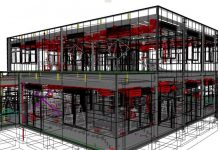Paul Reeve, Director of Business Services at the Electrical Contractors’ Association (ECA), looks at what needs to be done to boost supply chain readiness for the government’s April 2016 BIM threshold
We are now only months away from the government’s stated deadline for centrally procured construction projects to be ‘Level 2 BIM’ compliant. Bearing in mind that we are far closer to the April threshold than the government’s original announcement, we need to assess how ready we are as a sector, and whether we need to get a move on.
While larger construction contractors may be fully ready for the deadline, the supply chain is in a very different position. A survey carried out in by ECA in October, in partnership with CIBSE, B&ES, BSRIA, SELECT and the FSA, amongst others, suggests that just one in six building services firms are fully ready for BIM if a client requested it now. Since nearly 90 per cent of the firms surveyed were aware of BIM before the start of 2015, this is a significant ‘readiness gap’.
Larger building services engineering firms appear to be in good shape already, but clients may suffer from a lack of BIM capability down the line. Further results from ECA’s survey reveal a separate issue: more than half of contractors (54 per cent) with a turnover of less than £1 million are ‘not ready at all’ for Building Information Modelling (BIM), while 30 per cent of firms with an annual turnover of between £1 million and £20 million say they are in the same position. These firms are in clear and imminent danger of losing out on public sector work from next year.
One question though, is ‘why are the smaller companies not ready’? Are they not interested in the work, or are barriers preventing them from getting to grips with BIM? What’s causing ‘BIM inertia’ in our sector?
Our survey highlights that part of the reason is still lack of practical information. Nearly 62 per cent of respondents felt that there wasn’t enough ‘practically useful’ BIM information available to businesses.
Contractors need easily accessible information on BIM and clear, impartial advice on what they need to do to achieve BIM capability. I have yet to find a smaller contractor who thinks that the ubiquitous PAS 1192-2:2013 Specification for information management for the capital/delivery phase of construction projects using building information modelling is the first or best port of call for understanding what they need to do.
Another barrier is cost. Contractors are very practical and they deal with pressing practical problems every day. So far, few of them have encountered a serious conversation with a buyer about a BIM tender. To get on board, firms need access to competent BIM management and software staff. They also need the software. Many don’t see the need for this right now, and may not see the need for some time yet. None of this is hot news, but what it means is that there is only a small breakaway of firms from the main body, who are looking to join the flow on the way to BIM work.
But this won’t always be the case. Once businesses see BIM-compliance becoming a requirement to work, and they realise they could lose out on contracts they would and should have won, that small breakaway group could be followed by an army of contractors looking to tool-up, and quickly.
Perhaps the biggest challenge will not be cost, but finding suitably skilled people. Those who tend to opt for outside help may increasingly find cost and accessibility issues as others join the fray. Clients and others will be interested in reliability of delivery, and nowhere more than on a collaborative BIM project.
Anyone who has seen what building services engineers – and notably electrical engineers – do, will know that nothing in BIM is technically beyond their reach, even if it’s new. As such, the actual process of becoming BIM-ready isn’t too difficult once firms understand the two main aspects of BIM: modelling and collaborative management. The former is relatively easy to understand as it is dependent on having the right software – an investment firms will be willing to make when they can see the benefits of doing so – but the latter is often elusive. The construction supply chain has been encouraged by government to be more collaborative for decades, but it’s easier said than done because of the competitive nature of the market, and continuing small margins on projects.
BIM is a process tool – it mustn’t be called upon to change the prevailing culture in construction, or the attitude of clients, but it can certainly help. BIM can help clients to realise that there is better value to be had from both building and operating a building throughout its life-cycle. Perhaps 2016 will be the start of two things: a ‘BIM-rush’ as firms realise they need to engage, to keep or grow their market share, and an era where more public sector and other clients really start to push for collaboration. The building service engineers I have spoken to who have already become BIM ready have plenty of good words to say about it. Those words hinge around greater efficiency, and a bigger slice of the added value cake.
Paul Reeve
Director of Business Services
Electrical Contractors’ Association (ECA)
Tel: 020 7313 4800
















